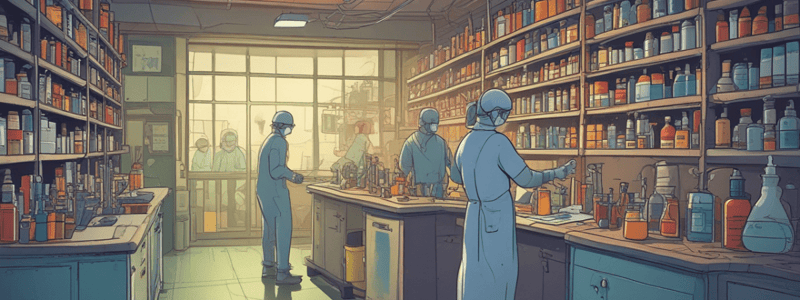Podcast
Questions and Answers
What is the primary consideration in a laboratory environment?
What is the primary consideration in a laboratory environment?
- Personal safety (correct)
- Cost-effectiveness
- Productivity
- Efficiency
Which type of hazard is not typically found in a laboratory environment?
Which type of hazard is not typically found in a laboratory environment?
- Biological
- Chemical
- Physical
- Meteorological (correct)
What is the primary purpose of a safety shower?
What is the primary purpose of a safety shower?
- To clean equipment
- To extinguish fires
- To flush contaminated skin or eyes (correct)
- To wash hands
What is the term for the process of reducing the number of microorganisms on a surface?
What is the term for the process of reducing the number of microorganisms on a surface?
What type of fire extinguisher is used for electrical fires?
What type of fire extinguisher is used for electrical fires?
What is the first step in managing a broken tube in a centrifuge?
What is the first step in managing a broken tube in a centrifuge?
What is the primary purpose of personal protective equipment (PPE)?
What is the primary purpose of personal protective equipment (PPE)?
What is the term for a substance that inhibits the growth of microorganisms?
What is the term for a substance that inhibits the growth of microorganisms?
What is the primary purpose of an eyewash station?
What is the primary purpose of an eyewash station?
What should you do if your feet do not touch the floor while sitting on an ergonomically designed chair?
What should you do if your feet do not touch the floor while sitting on an ergonomically designed chair?
What is the purpose of having a waste container in the BSC?
What is the purpose of having a waste container in the BSC?
Why should you avoid excessive movements of the hands and arms through the front opening?
Why should you avoid excessive movements of the hands and arms through the front opening?
What should you do upon completion of work in a BSC?
What should you do upon completion of work in a BSC?
What is the purpose of emergency showers and eyewash stations?
What is the purpose of emergency showers and eyewash stations?
What is critical in the event of a corrosive substance exposure?
What is critical in the event of a corrosive substance exposure?
Why should you keep clean items separate from dirty items in a BSC?
Why should you keep clean items separate from dirty items in a BSC?
What is a benefit of using emergency showers in cases of accident exposure?
What is a benefit of using emergency showers in cases of accident exposure?
Why should you routinely remove the work surface and disinfect the tray beneath?
Why should you routinely remove the work surface and disinfect the tray beneath?
What is the recommended action when handling chemicals and the skin or eyes come into contact with them?
What is the recommended action when handling chemicals and the skin or eyes come into contact with them?
Why is it important to store liquids below eye level?
Why is it important to store liquids below eye level?
What is the purpose of a safety data sheet (SDS)?
What is the purpose of a safety data sheet (SDS)?
Why should pregnant lab staff avoid areas displaying the radiation symbol?
Why should pregnant lab staff avoid areas displaying the radiation symbol?
What should you do when working with radiation?
What should you do when working with radiation?
What is the recommended action when handling a chemical spill?
What is the recommended action when handling a chemical spill?
What is the purpose of a chemical-resistant container in a spill kit?
What is the purpose of a chemical-resistant container in a spill kit?
Why should you minimize the quantities of chemicals in the laboratory?
Why should you minimize the quantities of chemicals in the laboratory?
Why should you segregate chemicals by reactivity class and flammability?
Why should you segregate chemicals by reactivity class and flammability?
What is the main priority when handling a biological spill?
What is the main priority when handling a biological spill?
What type of hazard is radiation an example of?
What type of hazard is radiation an example of?
What should you do with loose clothing in a laboratory?
What should you do with loose clothing in a laboratory?
What is the purpose of a safety hood in a laboratory?
What is the purpose of a safety hood in a laboratory?
What should be done with caustic materials after use?
What should be done with caustic materials after use?
What is the main purpose of performing preventative maintenance on laboratory equipment?
What is the main purpose of performing preventative maintenance on laboratory equipment?
What should be done with biological waste in a laboratory?
What should be done with biological waste in a laboratory?
What is the purpose of maintaining equipment logs in a laboratory?
What is the purpose of maintaining equipment logs in a laboratory?
What should you do with open-toed shoes in a laboratory?
What should you do with open-toed shoes in a laboratory?
What should you do if someone else wants to view the Safety Data Sheets?
What should you do if someone else wants to view the Safety Data Sheets?
What is the primary role of the response team in the event of a biological spill?
What is the primary role of the response team in the event of a biological spill?
What is the recommended dilution of bleach or other disinfectant solution for cleaning up a biological spill?
What is the recommended dilution of bleach or other disinfectant solution for cleaning up a biological spill?
How long should you allow the bleach solution to contact the spill area?
How long should you allow the bleach solution to contact the spill area?
What should you do after wiping down contaminated equipment or furniture with disinfectant?
What should you do after wiping down contaminated equipment or furniture with disinfectant?
What is the minimum amount of spill material that is usually considered a large spill?
What is the minimum amount of spill material that is usually considered a large spill?
What should you do if the spilled material goes through the grills to the catch tray?
What should you do if the spilled material goes through the grills to the catch tray?
What should you do first in the event of a large spill?
What should you do first in the event of a large spill?
What should you do after removing the paper towels and re-cleaning the area with disinfectant solution?
What should you do after removing the paper towels and re-cleaning the area with disinfectant solution?
Flashcards are hidden until you start studying
Study Notes
Laboratory Safety
- Laboratory safety is a top priority to ensure patient and personal safety.
Types of Hazards
- Chemical hazards: e.g., flammable liquids, toxic gases
- Physical hazards: e.g., radiation, noise, temperature (cold or hot), mechanical
- Biological hazards: microorganisms capable of causing disease, e.g., HIV
- Ergonomic hazards: elements related to workplace design that stress the body physically or mentally
- Psychosocial hazards: conditions of work that cause psychological stress to the worker, e.g., sexual harassment
Lab Safety Rules
- Nothing should be put in one's mouth
- Hands must be washed frequently
- Do not apply cosmetics in the lab
- No food should be placed in lab refrigerators
- Loose clothing should not be worn
- Long hair should be pulled back
- Open-toed shoes are prohibited in all areas of a lab
- Caustic materials must be disposed of according to SDS sheets
- Biological waste should be disposed of in a biohazard container and needles in a sharps container
Safety Equipment
- Safety showers and eyewash stations: provide on-the-spot decontamination and allow workers to flush away hazardous substances
- Fire extinguishers: different types are available for various types of fires (e.g., Class A, B, C, D)
- Personal protective equipment (PPE): includes safety goggles, face shields, gloves, and laboratory coats
Disinfection and Antiseptics
- Disinfection: process of eliminating or reducing microorganisms on a surface
- Antiseptics: substances that inhibit the growth of microorganisms on living tissue
- Examples of disinfectants and antiseptics: commonly used in laboratory settings
Dealing with Broken Tubes in the Centrifuge
- Containment procedures: protocols for safely managing broken tubes in a centrifuge
- Decontamination steps: including equipment maintenance procedures
Operating a Fire Extinguisher
- Procedures for handling biological spills: including containment, disinfection, and waste disposal
Biological Safety
- Definition of a biological spill: biological spillage is where a bodily fluid (e.g., faeces, urine, and blood) has been spilt
- Steps for responding to a biological spill: put on gloves, cover the area, prepare a bleach solution, soak paper towels, apply to the spill area, allow a 30-minute contact period, and clean up
General Safety Precautions
- Make sure equipment is safe to use
- Recognize and report any malfunctions
- Perform preventative maintenance
- Maintain equipment logs
- Store reagents safely
- Use safety hoods and biological safety cabinets (BSCs) correctly
- Follow proper procedures for working with radiation
Studying That Suits You
Use AI to generate personalized quizzes and flashcards to suit your learning preferences.




